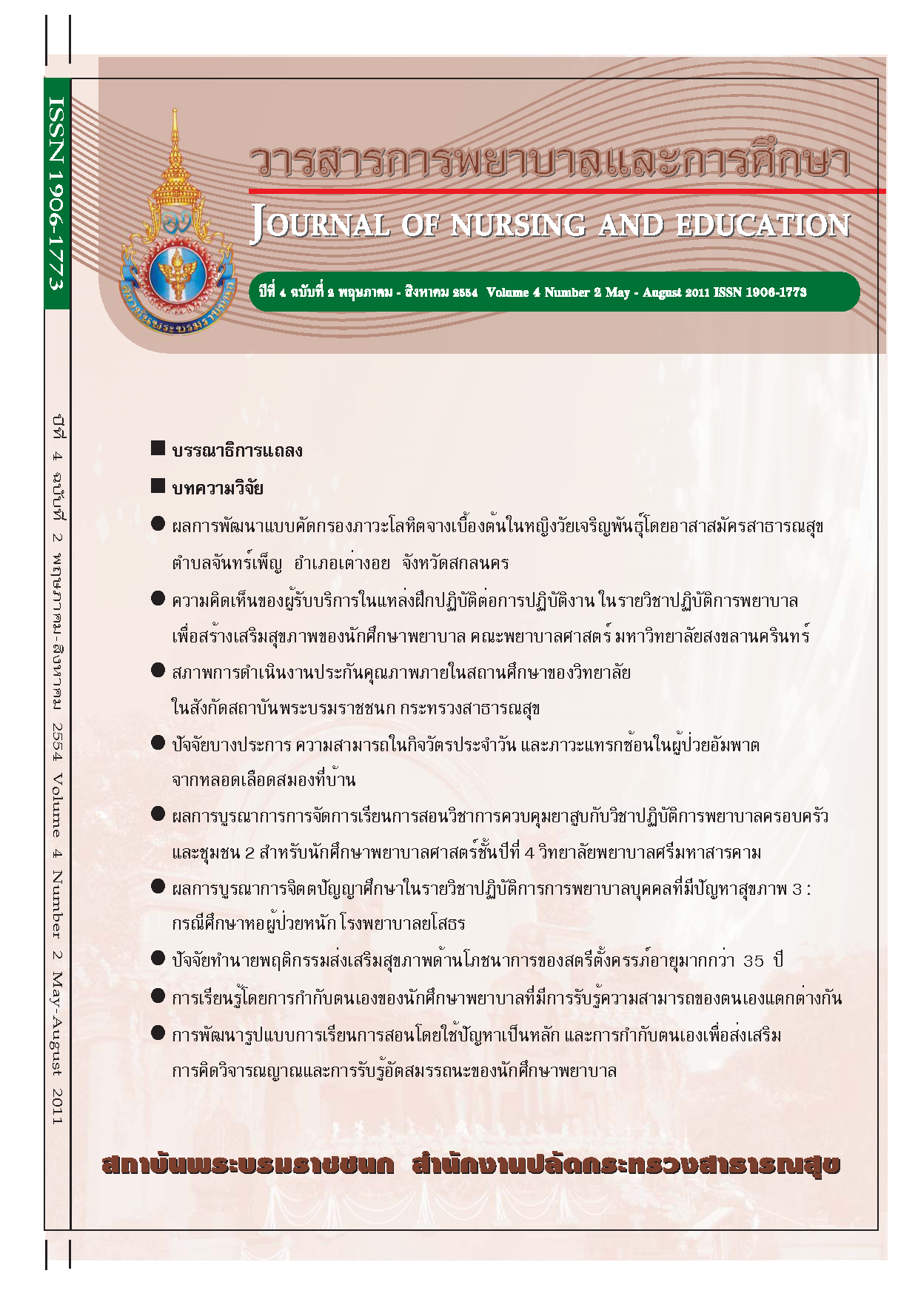การพัฒนารูปแบบการเรียนการสอนโดยใช้ปัญหาเป็นหลักและการกำกับตนเองเพื่อส่งเสริมการคิดวิจารณญาณและการรับรู้อัตสมรรถนะของนักศึกษาพยาบาล
คำสำคัญ:
Teaching-Learning model, problem-based learning, self regulation, critical thinking skill, self efficacy, learning achievementบทคัดย่อ
บทคัดย่อ
ปัญหาสุขภาพในปัจจุบันมีความซับซ้อนมากขึ้น พยาบาลจำเป็นต้องมีสมรรถนะสูงในด้านการคิด วิเคราะห์และตัดสินใจการจัดการศึกษาพยาบาลจึงต้องใช้วิธีการจัดการเรียนการสอนที่สามารถพัฒนา
ทักษะดังกล่าวได้การวิจัยนี้ใช้กระบวนการวิจัยและพัฒนา (Research and Development) มีวัตถุประสงค์ เพื่อพัฒนา รูปแบบการเรียนการสอนโดยใช้ปัญหาเป็นหลัก และการกำกับตนเอง และประเมินประสิทธิผล ของรูปแบบที่พัฒนาขึ้นจากคะแนนการคิดวิจารณญาณ การรับรู้อัตสมรรถนะ และผลสัมฤทธิ์ทางการเรียน กระบวนการศึกษาแบ่งออกเป็น 2 ระยะ คือระยะที่ 1 พัฒนารูปแบบการจัดการเรียนการสอน และระยะที่ 2 ศึกษาประสิทธิผลของรูปแบบการเรียนการสอนที่พัฒนาขึ้น
กลุ่มตัวอย่างในระยะที่ 1 คือผู้ทรงคุณวุฒิและอาจารย์พยาบาลที่มีความเชี่ยวชาญด้านการเรียน การสอนและการพยาบาล กลุ่มตัวอย่างในระยะที่ 2 คือนักศึกษาพยาบาลศาสตร์ชั้นปีที่ 2 ภาคเรียนที่ 2 ปีการศึกษา 2552 หลักสูตรประกาศนียบัตรพยาบาลศาสตร์ วิทยาลัยพยาบาลบรมราชชนนี พะเยา จำนวน 157 คน สุ่มตัวอย่างอย่างง่ายจำนวน 37 คนเข้ากลุ่มควบคุม ประเมินแรงจูงใจใฝ่สัมฤทธิ์นักศึกษาที่เหลือ 120 คน จากนั้นแบ่งออกเป็น 2 กลุ่มคือกลุ่มที่มีแรงจูงใจใฝ่สัมฤทธิ์สูง และต่ำกลุ่มละ 60 คน แล้วสุ่มอย่างง่าย เพื่อแบ่งกลุ่มตัวอย่างที่มีแรงจูงใจใฝ่สัมฤทธิ์สูง และต่ำเข้ากลุ่มที่จัดการเรียนการสอนโดยใช้ปัญหาเป็นหลัก และการกำกับตนเองกลุ่มละ 30 คน กลุ่มตัวอย่างทุกคนได้รับการประเมินการรับรู้อัตสมรรถนะ และการคิด วิจารณญาณก่อนและหลังการทดลอง และประเมินผลสัมฤทธิ์ทางการเรียนภายหลังการทดลอง เครื่องมือที่ใช้ใน การทดลองและประเมินผลผ่านการตรวจสอบคุณภาพโดยผู้ทรงวุฒิ และหาค่าความเชื่อมั่น โดยสถิติ
ผลการวิจัยในระยะที่ 1 ได้รูปแบบการเรียนการสอนโดยใช้ปัญหาเป็นหลัก และโดยการกำกับ ตนเองซึ่งประกอบด้วยองค์ประกอบและขั้นตอนที่นำไปใช้กับรายวิชาทางการพยาบาลได้ และในระยะที่ 2 ผลการประเมินประสิทธิผลของรูปแบบการเรียนการสอน 2 รูปแบบพบว่า 1) ไม่มีกิริยาร่วมระหว่างแรงจูงใจ ใฝ่สัมฤทธิ์และวิธีสอน 2) นักศึกษากลุ่มที่มีแรงจูงใจใฝ่สัมฤทธิ์สูง มีผลสัมฤทธิ์ทางการเรียนสูงกว่านักศึกษา กลุ่มที่มีแรงจูงใจใฝ่สัมฤทธิ์ต่ำอย่างมีนัยสำคัญทางสถิติที่ระดับ .01 3) นักศึกษากลุ่มที่เรียน โดยวิธีสอนแบบ ใช้ปัญหาเป็นหลัก มีผลสัมฤทธิ์ทางการเรียนสูงกว่านักศึกษากลุ่มที่เรียน โดยใช้การกำกับตนเองอย่างมี นัยสำคัญที่ระดับ .05 4) นักศึกษากลุ่มที่เรียนโดยวิธีสอนแบบใช้ปัญหาเป็นหลัก และกลุ่มที่เรียน โดยใช้การกำกับตนเอง มีผลสัมฤทธิ์ทางการเรียนสูงกว่านักศึกษากลุ่มควบคุม อย่างมีนัยสำคัญที่ระดับ.01 5) นักศึกษากลุ่มทดลองทั้ง 4 กลุ่มมีค่าเฉลี่ยคะแนนการรับรู้อัตสมรรถนะ และการคิดวิจารณญาณสูงกว่ากลุ่ม ควบคุมอย่างมีนัยสำคัญที่ระดับ.05
จากผลการศึกษานี้ผู้วิจัยมีข้อเสนอแนะให้วิทยาลัยพยาบาลในสังกัดสถาบันพระบรมราชชนก
ทุกแห่ง นำรูปแบบการเรียนการสอนทั้ง 2 รูปแบบไปใช้กับรายวิชาทางการพยาบาลเพื่อส่งเสริมสมรรถนะ ของบัณฑิตพยาบาลด้านการคิดวิจารณญาณ การรับรู้อัตสมรรถนะต่อไป
ABSTRACT
Nurses are demanded to have high competencies in analytical thinking and decision making as health problems are more complicated. Nursing education, thus need to be organized in a way to enhance these competencies. This research and development study was conducted to develop 2 teaching learning models using Problem–Based Learning (PBL) and Self regulation. Effectiveness of the models was
examined by evaluating the students’ critical thinking, self efficacy, and learning achievement. The study was divided into 2 phases, Phase 1: Model development and Phase 2: Evaluation of the model
effectiveness.
The sample for the first phase were experts and nursing instructors experienced in nursing and education while the second phase included 157 Year 2 nursing students in Semester 2 Academic Year 2 of bachelor degree program of Boromarajonani College of Nursing Payoa. A random sampling technique was used to split 37 students into a control group. The rest of 120 students were then divided into 2 groups of high and low achieved motivation by a questionnaire. The students from each group were randomized into the groups of PBL and self regulation. All students were assessed by self efficacy and critical thinking questionnaires before and after experiment whilst their learning achievement was examined after the
experiment. All questionnaires were approved by experts and statistically tested for reliability.
The results from Phase 1 yielded the model of teaching-learning based on PBL and the model of teaching-learning based on self regulation composed of components and processes which can be applied for nursing courses. The results from Phase 2 revealed that 1) there was no interaction between the achieved motivation and the teaching methods; 2) learning achievement of the students with high achieved
motivation were statically significant higher than that of the low achieved motivation group (p < .01); 3) learning achievement of the students who were taught by PBL model were statistically significant higher than that of those taught by self regulation model (p < .05); learning achievement of all experimental groups were statistically significant higher than that of the control group (p < .01); self efficacy and critical thinking scores of all experimental groups were statistically significant higher than that of the control group (p < .05).
The findings of this study suggest that the two models of PBL and self regulation should be used with nursing courses in the nursing colleges of Praboromarajchanok Institute to promote competencies of critical thinking and self efficacy.






